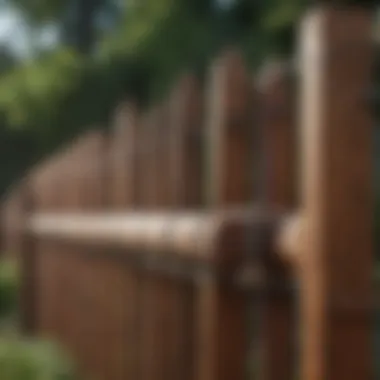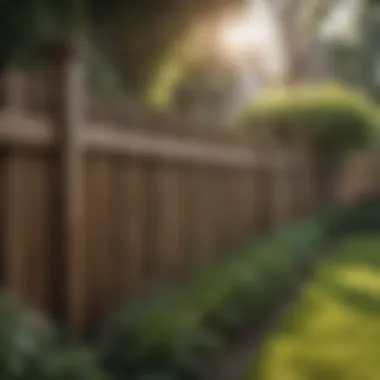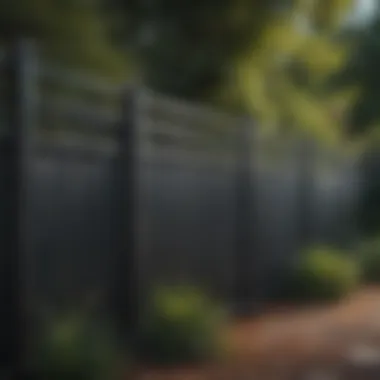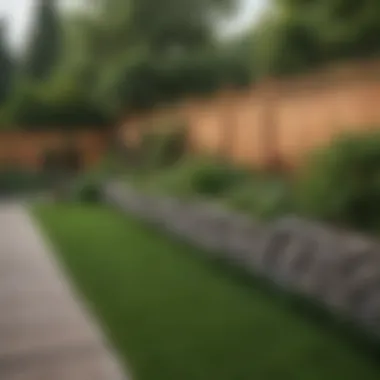Fencing Costs: A Comprehensive Guide for Homeowners


Intro
Fencing your yard is an significant investment. The choices you make in materials, style, and installation can all affect the total cost. This guide aims to demystify the factors at play in the pricing of fencing. Understanding these elements allows homeowners to navigate options wisely and financially responsibly.
Fences serve various purposes from providing privacy, to enhancing beauty, and ensuring security. Hence, making the right decision requires careful consideration of what is available and relevant to your unique needs.
Before diving into the specifics of fencing costs, it is critical to understand the wide array of factors that contribute to the overall price. These factors include the types of materials available, any design preferences, installation requirements, and geographic location. Additionally, hidden expenses may arise that should be factored into any budgeting discussion.
In this guide, we will provide a comprehensive overview of fencing costs, touching on each key area to allow you to make an informed decision. With this knowledge, you will be better equipped to enhance your outdoor space effectively and affordably.
Design Inspiration
While the primary function of a fence is practical, its design also significantly affects cost and aesthetic appeal. When considering fencing options, think about current trends and styles.
Material Choices
Selecting the right material can elevate the fence's look while staying within budget. Common materials include:
- Wood: Offers natural beauty but may require more maintenance.
- Vinyl: Provides durability and low upkeep.
- Chain Link: An economical option but less visually appealing.
- Metal: Offers strong security and modern appeal.
Style Factors
Different design inspirations can also impact your costs. Open picket styles may cost less than solid privacy designs. Consider the fencing’s height and style as they directly influence pricing.
"While aesthetics matter, don't forget about your property's local regulations regarding height and material choices."
Installation Considerations
The installation of your fence is not only a key cost consideration but also influences how long you can expect it to last. Professional installation offers advantages over DIY, including experience and efficiency.
Hiring Professionals vs DIY
- Professional Installation: Allows for the guarantee of quality work. Prices vary significantly based on labor and complexity of design.
- DIY Installation: Can save on labor costs, but will require tools and potentially more time. Mistakes can lead to higher long-term costs.
Investing in high-quality installation is advisable for longevity and functionality.
Maintenance Needs
Once your fence is installed, ongoing maintenance will also impact overall costs. Every material requires different levels of upkeep.
- Wood Fencing: Needs regular staining or painting.
- Vinyl Fencing: Generally easy to clean but may require replacement for damaged sections.
- Chain Link Fencing: Little maintenance is often needed.
Hidden Costs
Consider that hidden costs may arise throughout the fencing process. This can include:
- Permitting Fees: Often required for installation in certain areas.
- Site Preparation: Additional costs for land clearing or grading.
- Landscaping Changes: May be necessary depending on layout.
This guide aims to clarify the complex nature of fencing costs, enabling homeowners to make informed choices. Being aware of all aspects, from materials to hidden expenses, allows for better planning and realization of desired outdoor spaces.
Understanding Fencing Costs
Understanding fencing costs is crucial for homeowners. It influences decisions about the type, style, and quality of fencing. A well-planned budget ensures the right investment for privacy, security, and aesthetics. Ignoring these costs can lead to overspending or dissatisfaction with the final result.
When considering fencing, it is important to grasp how different materials affect overall expenses. Understanding the market trends can guide buyers to make wise choices related to their specific needs. The relevance of knowing fencing costs extends beyond initial purchase prices, as maintenance and long-term value must also be considered.
Additionally, factors such as yard size and geographic location play significant roles in determining costs. A comprehensive understanding helps to avoid unexpected expenses and allows homeowners to plan effectively, optimizing their outdoor spaces without overshooting budgets.
Overview of Fencing Materials
Fencing materials vary widely in cost and characteristics. Common options include wood, vinyl, metal, and chain link. Each of these materials presents distinct advantages and drawbacks. For instance, wooden fences are popular for their classic appearance but may require more maintenance compared to vinyl, which is often easier to care for in the long run.
Here are some materials and their general pros and cons:


- Wood Fencing:
- Vinyl Fencing:
- Metal Fencing:
- Chain Link Fencing:
- Pros: Attractive, customizable
- Cons: Vulnerable to weather, higher maintenance
- Pros: Durable, low upkeep
- Cons: Higher upfront costs
- Pros: Strong, secure
- Cons: Can be expensive
- Pros: Affordable, functional
- Cons: Less privacy, fewer aesthetic options
Knowing these characteristics aids homeowners in selecting materials that meet both budgetary and personal preferences effectively.
Market Trends Affecting Prices
The cost of fencing is influenced by market fluctuations. Factors such as supply chain issues, changes in material availability, and demand trends can drive prices up or down. For instance, lumber prices experienced volatility in recent years, impacting the overall cost of wood fences.
Understanding these trends is essential. Homeowners should pay attention to local markets and timing their purchases can lead to significant savings.
Additionally, economic factors such as inflation play a role in pricing. Knowing when to buy can make a difference in expenses over time. Staying informed about market conditions ensures homeowners are prepared and can take advantage of favorable pricing.
"The prices of building materials fluctuate, impacting fencing options for homeowners considerably."
Types of Fencing Materials
Fencing materials significantly impact the overall cost and functionality of a yard. Homeowners need to understand the variety of fencing options available, as each has unique benefits, drawbacks, and price points. Selecting suitable materials can enhance security, aesthetics, and durability, ultimately affecting the long-term value of a property. The right fencing choice provides not just a barrier but also complements the landscape, potentially increasing curb appeal. Each material listed below brings its own distinct characteristics that can cater to various homeowner needs.
Wood Fencing
Wood fencing remains a popular choice due to its natural appearance and versatility. However, costs can vary mainly based on the type of wood used and the intricacies of installation.
Cost Variations by Wood Type
Different wood types present various pricing levels. For instance, a cedar fence will likely cost more than a pine fence. Cedar is valued for its resistance to rot and insects. In contrast, pine is often less expensive but may require more maintenance. Understanding these cost variations is important for homeowners looking to balance initial outlay with long-term durability. The unique trait of wood fencing is its natural aesthetic appeal, making it a favored option among those seeking warmth in their outdoor spaces.
Installation Expenses
Costs associated with installation can add significantly to the overall expense of wood fencing. Hiring professionals can be necessary, especially for complex designs or uneven ground. Installation expenses can vary depending on local labor rates and the complexity of the job. A key characteristic of wood fencing installation is the need for accurate measurements to ensure a proper fit and alignment. On the positive side, well-installed wood fencing can last for many years, contributing to its value as a long-term investment.
Maintenance Considerations
Wood fencing requires regular maintenance to ensure longevity. This often includes staining or sealing to protect against moisture and UV damage. Homeowners must consider these ongoing costs and labor involved in upkeep. While an appealing choice initially, the maintenance aspect can deter some from choosing wood fencing if they prefer a low-maintenance option.
Vinyl Fencing
Vinyl fencing is increasingly chosen for its durability and low maintenance. Unlike wood, it does not decay, and it usually comes at a price which can be more attractive in the long run.
Initial Costs vs. Long-term Value
Initially, vinyl may cost more than wood. However, it often pays off over time due to its resistance to many environmental factors, needing less repair or replacement. This balance makes it a wise option for those seeking longevity. The unique feature of vinyl fencing is its ability to mimic the look of wood while providing significant practical advantages, such as being rust-proof and resistant to splintering.
Durability and Maintenance
Vinyl fencing can withstand harsh weather conditions and does not require painting or staining. Regular cleaning with soap and water typically suffices to maintain its appearance. This low-maintenance requirement appeals to busy homeowners. Its durability means that, although the upfront costs might be higher, long-term care costs remain low.
Design Options
Vinyl fencing is available in numerous styles and colors, allowing homeowners to customize their yards. The range of design options provides flexibility in aligning with existing garden aesthetics. This variety contributes to its popularity, as it can complement a multitude of home styles. Often, the only disadvantage is that vinyl may lack the classic aesthetic appeal that natural materials provide.
Metal Fencing
Metal fencing presents a sturdy option that enhances security while adding a modern touch.
Aluminum vs. Wrought Iron


When considering metal fencing, the choice between aluminum and wrought iron is crucial. Aluminum is often lighter and more affordable than wrought iron, yet lacks the same level of strength. Wrought iron, while more expensive, offers unmatched durability and security. The choice largely depends on the specific needs, whether the priority is decorative elegance or structural strength. Wrought iron typically needs more maintenance to prevent rust, while aluminum requires less ongoing care.
Cost Effectiveness Over Time
Metal fencing may have higher upfront costs, especially for wrought iron, but can often be cost-effective over time due to lower maintenance and longevity. Homeowners should weigh their choices based on budget and longevity expectations. The fact that metal fencing is less likely to incur replacement costs over time can make it a smart investment, particularly in areas prone to extreme weather or vandalism.
Style and Security Features
Metal fencing can enhance security while offering aesthetic appeal. Many designs include intricate patterns and tailored features to match a homeowner's preferences. This style aspect, combined with its inherent sturdiness, positions metal fencing as a favored choice for those seeking both beauty and security in their yards.
Chain Link Fencing
Chain link fencing provides a practical and budget-friendly option for homeowners.
Affordability and Functionality
With one of the lowest price points among fencing materials, chain link is highly functional for basic property delineation and security without significant financial commitment. It offers a lasting solution while being both affordable and practical. This material’s versatility makes it useful for various purposes, including keeping pets in or creating safe play areas for children.
Customizable Options
Although traditional, chain link fencing can be customized with color coatings to enhance aesthetics or privacy slats for added seclusion. Homeowners benefit from flexible options tailored to their needs. This customization has the potential to transform a simple chain link fence into a more decorative feature, although it may still not achieve the sophisticated look of other materials.
Installation and Upkeep Costs
Chain link fences are typically easy and quick to install, keeping labor costs low. Maintenance requirements are minimal, mainly involving occasional inspections for rust or wear. The installation and upkeep savings make this option appealing to many homeowners, though it lacks the same privacy offered by solid fencing alternatives.
Each of these materials brings distinct advantages to various fencing needs. Evaluating personal requirements will ultimately help determine the best fit for each individual homeowner's yard.
Factors Influencing Fencing Prices
Fencing prices can vary significantly based on several crucial factors. Understanding these influences is vital for homeowners who want to ensure that their budgets align with the expectations for fencing their yards. Factors such as yard size, legal requirements, and geographical location play significant roles in determining costs. Each element can either inflate or reduce the total investment necessary to complete a fencing project, which this section will explore in detail.
Yard Size and Configuration
The size and configuration of your yard are fundamental to the overall fencing cost. A larger yard naturally increases the amount of material required, leading to higher expenses. Additionally, unique configurations, such as irregular shapes or various levels, might necessitate more custom solutions. For instance, a straight, rectangular yard generally costs less to fence than a yard with numerous curves and slopes. Therefore, it is essential to assess your yard's dimensions and versatility before making decisions.
Permitting and Legal Issues
Permitting can sometimes be overlooked by homeowners when planning to build a fence. However, many local jurisdictions require permits before installation can commence. The process of acquiring a permit includes fees that vary by location. Furthermore, adhering to local regulations about fence height, style, and placement is crucial. Failure to comply can result in fines and additional costs for compliance. Homeowners should conduct thorough research about their area's regulations to avoid potential pitfalls.
Geographic Location and Local Costs
Geographic location profoundly affects fencing prices. Different regions exhibit varying costs for labor and materials. For example, areas with higher living costs will likely experience elevated prices for materials such as wood or vinyl. Local weather conditions may also influence specific choices, like opting for rust-resistant metal in places prone to high humidity. Furthermore, availability can dictate pricing. It's vital for homeowners to get quotes from local suppliers and contractors to gain a realistic understanding of the expenses involved in their area.
"Understanding the specific factors that influence fencing costs can lead to more informed decisions, allowing for a smoother project execution and budget adherence."
This nuanced understanding of all these aspects not only helps homeowners budget appropriately but also empowers them to make choices that align well with their unique circumstances. When planning a fencing project, attention to these factors is essential for avoid unnecessary financial strain.
Installation Considerations
When planning to fence in your yard, installation considerations play a vital role in determining the overall success of the project. Understanding the implications of installation can help homeowners avoid unnecessary expenses and complications. Decisions made during this phase can affect both the upfront costs and long-term functionality of the fencing. Furthermore, evaluating the pros and cons of DIY methods versus hiring professionals will guide homeowners toward making informed choices that fit their unique needs.
DIY vs. Professional Installation
Cost Comparisons
Cost comparisons between DIY and professional installation are essential in making financial decisions regarding fencing. The key characteristic of DIY methods is their potential for lower upfront costs. Homeowners can save on labor fees, which are often a significant portion of the total installation price. However, the trade-off comes in the form of time investments and the risk of costly mistakes. For example, improperly installed fencing can lead to damage that requires future repairs. Thus, while DIY can be a beneficial choice for budget-conscious individuals, it may not always yield the savings anticipated.
Skills Required for DIY
The skills required for DIY projects vary based on the complexity of the fencing type. A key characteristic of DIY installation is that it demands a good understanding of tools and techniques involved. This choice can be empowering for skilled individuals, allowing them to express creativity and personal touch in their yard. Nonetheless, those lacking experience in construction may face challenges. Incorrect measurements or unstable posts are common mistakes that could worsen the project's outcome. Therefore, considering one's skill level is critical for evaluating whether to go the DIY route or not.
Benefits of Hiring Professionals


Hiring professionals offers significant advantages in the installation process. The main benefit is the assurance of quality workmanship, which can save money in the long run. Professionals bring their expertise and tools to the project, minimizing errors during installation. Their familiarity with local regulations and requirements can also expedite the process. While this option comes at a higher upfront cost, the unique feature of professional installation is the peace of mind it provides. Homeowners can enjoy their fenced spaces sooner without worrying about future repairs due to installation mishaps.
Timeframe for Installation
Timely installation is another critical aspect that homeowners must consider. The timeframe for installation varies based on whether you choose a DIY approach or hire professionals. DIY projects could stretch longer, especially if working on weekends or evenings. Conversely, professional teams typically complete installations more swiftly due to experience and manpower. This efficiency can significantly reduce the overall project duration, allowing homeowners to enjoy their new fencing sooner.
"Selecting the right installation method is essential in balancing cost, time, and quality."
Both approaches, DIY and professional, have their merits. Evaluating all factors, including skills, costs, and timelines, will empower homeowners to make decisions that reflect their priorities and ensures the fencing process goes as smoothly as possible.
Long-term Costs of Fencing
Understanding long-term costs associated with fencing is crucial for any homeowner considering an investment in their property. The initial price of purchasing and installing a fence can be significant, but this is often just the beginning. Long-term costs encompass various ongoing expenses, making it essential to examine how they can impact overall budgeting and decision-making.
Maintenance and Repairs
Every type of fence requires some form of maintenance and potential repairs over its lifespan. How often you will need these services depends on the material selected and environmental factors specific to your location.
- Wood Fencing: This option typically demands frequent inspections for rot or insect damage. Regular sealing or staining can also prolong lifespan, adding to long-term costs.
- Vinyl Fencing: It tends to require less maintenance compared to wood. Occasionally, it may need a wash to remove dirt or mildew, but it rarely needs replacement parts, which is cost-effective.
- Metal Fencing: Depending on the type, such as aluminum or wrought iron, it may need this scheduled maintenance. Rust prevention measures are also essential for longevity.
- Chain Link Fencing: Maintenance for chain link is relatively low, but rust can be an issue in certain environments. Painting and replacing damaged sections may add to your long-term costs.
Regular maintenance not only preserves the aesthetics of a fence but also its structural integrity. Homeowners should budget for these expenses to avoid unexpected financial burdens down the line.
Insurance Implications
Investing in a fence also has implications for property insurance. Many homeowners do not consider how adding a fence can influence their insurance premiums.
- Increased Coverage Costs: A fence may increase the assessed value of your property. This could lead to higher premiums. However, some insurers may offer reduced rates if the fence enhances security.
- Liability Considerations: If a fence encloses a pool or property line, insurers may factor in potential liabilities. Homeowners should communicate with their insurance providers to adjust their policies accordingly, mitigating risks associated with trespassing or accidents on their property.
The initial investment in fencing can significantly affect your insurance policy, making it essential to understand these implications clearly.
When factoring in long-term costs related to maintenance, repairs, and insurance implications, the initial fence price becomes part of a broader financial strategy. Homeowners must assess these elements comprehensively to ensure the fence is a sound investment, aligned with their long-term property plans.
Hidden Costs to Consider
When planning to install a fence, many homeowners focus primarily on the visible and tangible costs such as materials and labor. However, hidden costs can emerge unexpectedly and significantly inflate the total expenditure. Understanding these costs is crucial for accurate budgeting and ensuring a successful fencing project. This section will address the common hidden costs associated with fencing installations, ensuring that you are fully prepared.
Landscaping Adjustments
Before erecting a new fence, it is important to carefully assess the landscape of your yard. Various factors may require adjustments to your landscaping, including tree removal or relocation of shrubs. These adjustments can accrue added expenses that should be factored into your overall budget.
- Tree Removal: Depending on the size and type of trees present, removal can be costly. Typically, hiring a professional service ensures safe removal.
- Shrub Relocation: If you prefer to keep existing plants, this requires careful excavation and replanting, which can also add up in cost.
- Ground Preparation: Landscaping holes or existing features like fences need to be leveled and prepared before installation. Depending on soil conditions or additional features, this might require earth-moving equipment or labor.
Properly addressing landscaping adjustments can prevent potential damage during installation and lead to a more aesthetically pleasing result once the fencing is in place.
Upgrading Utilities Before Installation
In some situations, homeowners may find that underground utilities must be upgraded prior to fence installation. Often overlooked, this particular hidden cost can be substantial, especially if your yard has outdated wiring or plumbing systems. It is essential to investigate prior to installation to avoid disruption during the process.
- Call Before You Dig: Always check for local utility companies to mark out existing lines before starting the project. This can help you identify areas that may require further excavation or precautions.
- Upgrading Electrical or Water Lines: If you discover any lines that are outdated or need repair, this involves additional costs. This can include hiring professionals and purchasing new materials.
- Permitting Costs: Upgrading utilities may also require permits from local authorities which can incur extra fees.
Planning for these potential expenses helps avoid frustration and delays. Being proactive can save time and resources in the long run.
"Hidden costs, often unnoticed, can be the differentiating factor in the feasibility of a fencing project. Budgeting realistically requires looking beyond the surface."
By understanding and preparing for the hidden costs associated with your fencing project, you will be in a better position to make informed and effective decisions. This not only leads to a successful installation but also enhances your ability to optimize your outdoor space.
Finale
In the journey of selecting and installing a fence, understanding the associated costs is crucial for homeowners. This article has outlined the key factors and considerations that influence fencing prices. From the choices of materials to installation methods, each decision carries financial implications.
Making Informed Decisions
When contemplating a fencing project, making informed decisions is imperative. Homeowners should assess the specific needs of their property, the desired aesthetic, and long-term maintenance requirements. For instance, choosing between wood, vinyl, or metal options requires careful evaluation of initial costs, durability, and upkeep.
Factors such as local regulations, yard size, and landscape configurations also influence overall expenses. Evaluating these elements allows homeowners to accurately budget for their fencing project. Researching local contractors and obtaining multiple quotes can provide clarity on installation costs. Additionally, reviewing reviews and past work can ensure that quality is not compromised. An informed decision can lead to a practical investment that enhances both function and appeal while avoiding unexpected expenses in the future.
Future Trends in Fencing Costs
As we look into the future, several trends may reshape fencing costs and consumer choices. Innovations in materials, such as sustainable options and smart fencing technology, are gaining traction. Homeowners are increasingly interested in eco-friendly materials, which often lead to lower long-term maintenance costs.
Furthermore, the impact of automation and home security advancements cannot be overlooked. Fencing options that integrate technology to enhance property security may come with higher upfront costs but could provide savings on insurance premiums and peace of mind.















